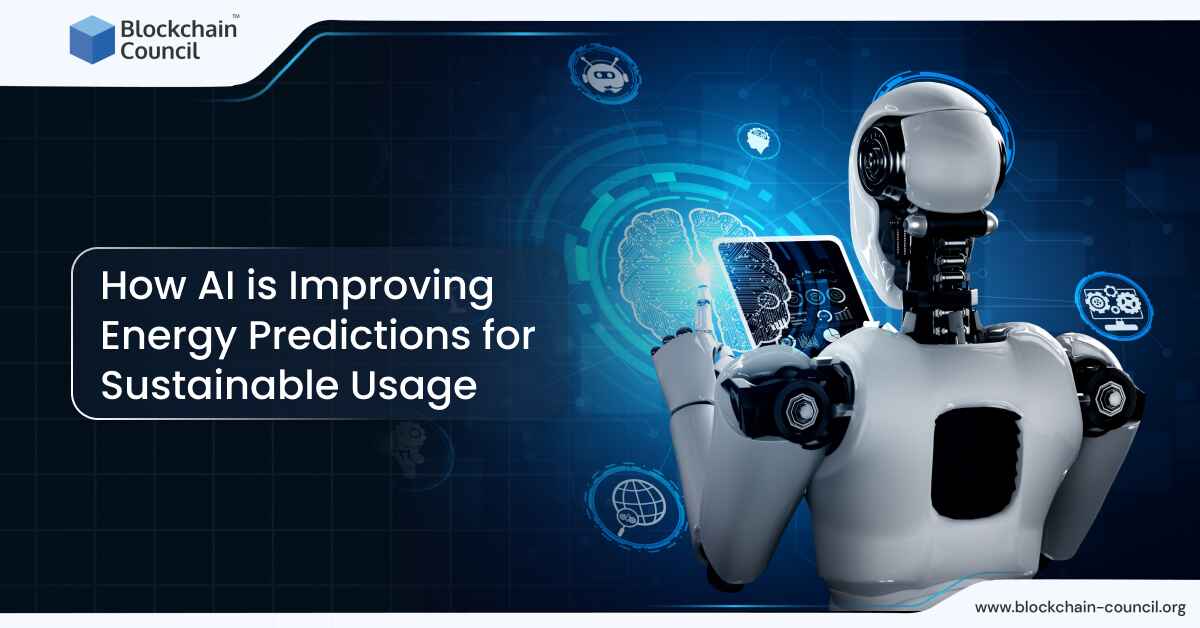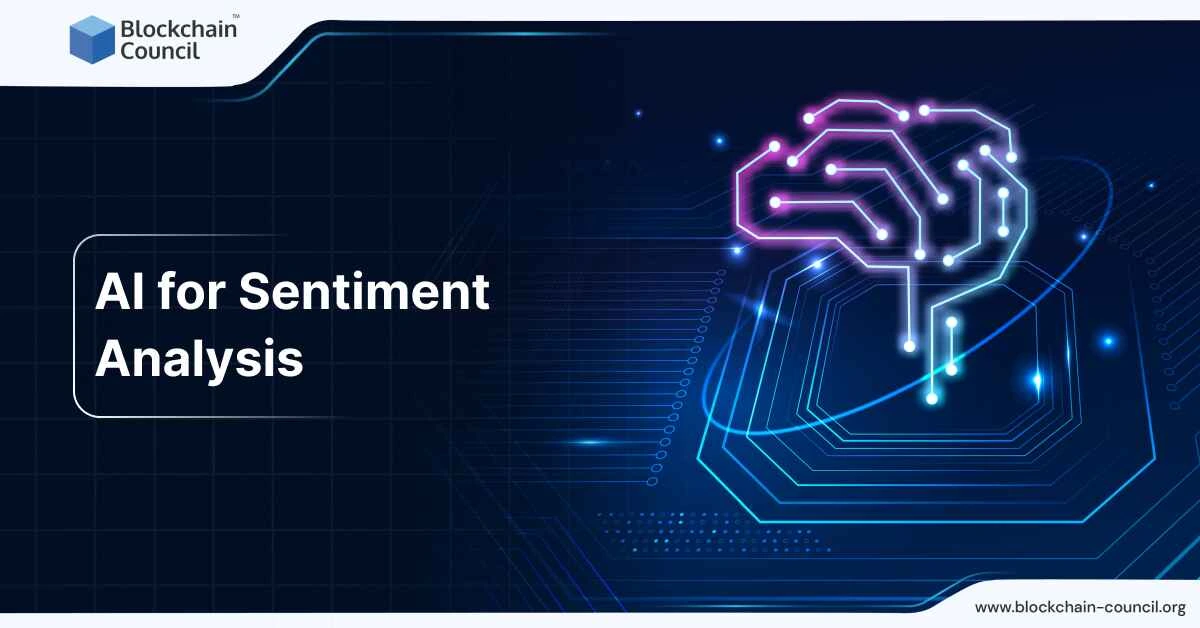
- Blockchain Council
- November 11, 2024
Artificial intelligence (AI) is increasingly becoming a useful resource in improving energy predictions and supporting sustainable energy practices. With growing environmental concerns, AI is helping energy systems operate more efficiently and manage the demand for clean power more effectively.
The Role of Energy Forecasting
Energy predictions are vital for balancing supply and demand within the electrical grid. Traditional energy sources, such as coal and gas, offer more predictable outputs, but renewable sources like wind and solar are harder to predict because they rely on weather. For instance, solar energy production dips at night or when clouds block the sun, and wind power depends on varying wind speeds. These variations can make it difficult to keep the energy grid stable and reliable.
Accurate forecasting is essential for energy companies to manage these fluctuations, ensuring supply can meet demand at all times. This prevents outages and reduces the need to turn to less eco-friendly sources when renewable power falls short. AI is becoming a key tool in improving the accuracy of these predictions.
AI’s Impact on Energy Efficiency in Data Centers
While AI-driven technologies have helped in many areas, they have also raised concerns about energy consumption, particularly in data centers. AI models, especially those used to train complex neural networks, consume a lot of power. Yet, new developments in AI hardware are helping to reduce this impact. For example, NVIDIA has developed more efficient AI chips that cut down energy usage. One of their products, the Grace Hopper Superchip, uses significantly less power compared to earlier models, while still maintaining strong performance.
AI is also being used within data centers themselves to optimize how energy is used. By predicting workload demands and adjusting energy consumption, AI can ensure these centers operate more efficiently. Additionally, many tech companies are looking into powering these centers with renewable energy, further reducing their environmental impact.
Earning the Certified Artificial Intelligence (AI) Expert™ certification helps you understand how AI can improve energy forecasting and promote sustainable energy use.
AI and Renewable Energy Management
One of the major challenges in using renewable energy sources like wind and solar is their unpredictability. Since they rely on weather conditions, they can’t offer a steady stream of energy like fossil fuels can. This is where AI becomes particularly valuable. By using real-time weather data and historical trends, AI can predict when wind and solar power will be available. These systems can forecast energy availability for hours, days, or even weeks.
For example, AI-powered models are now used in solar power setups to predict cloud cover, allowing for better energy storage strategies. This ensures that solar energy is efficiently used when available, while surplus power can be stored during times of low sunlight. Similarly, AI tools can predict peak wind energy production, helping grid managers allocate resources more efficiently.
Additionally, AI is being applied to maintain renewable energy infrastructure. Companies like Snam and Shell are using AI to monitor equipment like wind turbines and solar panels, identifying potential issues before they cause failures. This helps reduce downtime and keeps energy production running smoothly.
Addressing Energy Usage in AI Systems
While AI offers solutions to improve energy use, it also presents its own set of challenges, especially with the power needed to run these systems. Training AI models requires processing vast amounts of data, which consumes a lot of electricity. To tackle this, companies are developing more energy-efficient AI hardware and software. For example, NVIDIA’s newer AI systems have significantly reduced the amount of energy required by optimizing how computing processes are handled.
AI is also being used in “smart grids” to monitor energy consumption in real-time. These systems adjust the distribution of energy based on current needs, ensuring that energy is not wasted. This can be particularly helpful in areas that are moving toward carbon-free energy systems.
AI’s Contribution to Fighting Climate Change
The role of AI in energy forecasting and management is an essential part of global efforts to address climate change. By making renewable energy systems more efficient, AI reduces reliance on fossil fuels, which are a significant source of carbon emissions. AI also makes it easier for energy providers to blend renewable sources into the grid, allowing for a larger share of clean energy.
AI’s impact extends to global sustainability goals, such as the United Nations’ Sustainable Development Goal 7 (SDG7), which aims to provide affordable and sustainable energy for everyone. In regions like the Global South, AI-powered energy systems are helping expand access to clean energy while supporting economic growth.
If you want to learn more about AI and energy forecasting, the Master Artificial Intelligence (AI) Learning Path can give you the guidance to enhance your impact on sustainability efforts.
Recent Innovations in AI-Powered Energy Forecasting
- One of the most innovative developments in this space is the Sup3rCC model created by the National Renewable Energy Laboratory (NREL) in 2023. This tool uses machine learning to improve the accuracy of renewable energy predictions by combining weather data with local climate information, such as wind speeds and solar radiation levels. Sup3rCC helps planners manage energy supply better by providing detailed and timely forecasts. This is particularly useful for avoiding power shortages during extreme weather conditions, as experienced in California and Texas.
- In 2024, NVIDIA continued its progress in AI-driven energy efficiency. Their DGX systems managed to save a lot of energy by improving how data centers operate. These systems reduce the power required for intensive data tasks, making them more efficient. As data centers consume a large portion of global energy, improving their efficiency is crucial for energy sustainability.
- Additionally, companies like Microsoft are using AI to predict energy needs and improve grid management. Their partnerships, such as with Ontario Power Generation, show how AI can help in analyzing real-time data from energy grids. AI tools are also being used to conduct virtual inspections of power lines, improving maintenance efficiency.
AI’s Broader Impact on Global Energy Sustainability
Beyond specific cases, AI plays an essential role in shifting the global energy landscape toward sustainable use. Machine learning helps energy providers incorporate renewables into their systems, ensuring that green sources are prioritized over fossil fuels. AI also improves energy use in areas like manufacturing, transport, and commercial buildings, reducing carbon emissions across different sectors.
Countries in emerging markets, such as Kenya and Nigeria, are beginning to see the benefits of AI-powered energy strategies. These nations are using AI to create plans that expand access to clean energy, supporting both sustainability and economic development.
With AI becoming more vital in energy forecasting, the Certified Artificial Intelligence (AI) Developer™ credential equips you to design more accurate and efficient systems for sustainable energy management.
Conclusion
AI’s role in improving energy predictions and supporting sustainable energy use continues to expand. From boosting renewable energy production to enhancing grid management, AI is proving to be a valuable tool in building a more efficient, reliable, and clean energy system. As technology advances, the potential for AI to assist in the global shift toward cleaner energy will only continue to grow.
AI-driven energy forecasting has its challenges. Our Unlimited Learning Subscription (AI) gives you access to the resources to meet the demands of the sustainable energy sector.





































































 Guides
Guides News
News Blockchain
Blockchain Cryptocurrency
& Digital Assets
Cryptocurrency
& Digital Assets Web3
Web3 Metaverse & NFTs
Metaverse & NFTs
